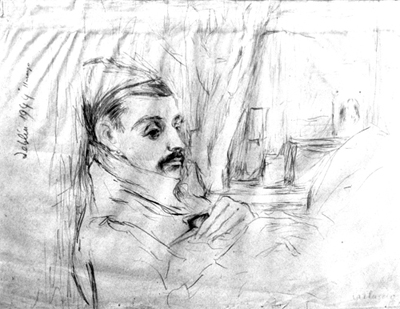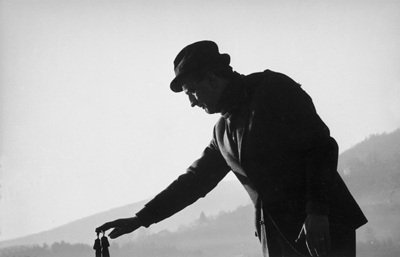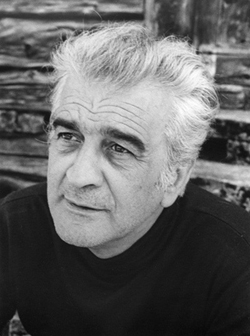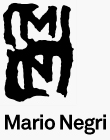“
1916
Mario Negri was born in Tirano, Valtellina on 25 June, not far from the Swiss border at Campocologno. His mother was Giuseppina Tognolini (1880-1935) and his father Carlo Negri (1877-1933), a builder. Mario was the last of four children and went to school in Genoa, where his father had moved, invited by his brother Rinaldo who lived there and worked as an engineer. After moving to Milan in 1928, Mario continued his studies and graduated at the Manzoni classical high school in 1936. In the autumn of that same year he took a degree at the Brera Academy of Fine Arts in Milan. He then decided to study architecture at the Milan Polytechnic, where he attended the first two years; at the beginning of the third year, his father died and he was forced to withdraw: «Then my father passed away and two years later my mother passed away too, so when I was at the end of the lyceum, I had to reassure my brother of my choice. It had to be based on a good future job and provide a good career for me. That is why I attended only the first three years at the Polytechnic of Milan. I would have really liked to be an architect […] yet I also understood that it was a choice based on duty, not only on my desires. […]» (Interview at Italian-Swiss Radio, 1970s). From 1935 to 1940 he met and spent time with a group of artists and intellectuals who were linked to the magazine «Corrente di vita giovanile». He became friends with Sandro Cherchi and Italo Valenti. He also frequented the studio of Giacomo Manzù, who had done a portrait of his father, possibly basing it on his death-mask.
1940
Negri was summoned for military service at the start of the year, and stationed in Bolzano as an instructor for the Genio Pontieri (pontoon corps). He remained there until 8 September 1943. On 9 September he was captured by the Germans at Bressanone. He was among the hundreds of thousands of I.M.I. (Internati Militari Italiani) seen as traitors by Hitler because of Badoglio’s about-face and their refusal to accept Fascist and Nazi rule. He was deported in a cattle car along with his battalion and held in various German and Polish prison camps (Oberlangen, Bremervörde, Wietzendorf, Deblin-Irena), and did not return to Milan until 1945. While there he found comfort in the friendship he developed with his companions in the detention camps, including Luigi Carluccio, Leone Pancaldi, Roberto Rebora, Romeo Lucchese, Giuseppe Bortoluzzi, Ettore Bonora, Enzo Paci, Giuseppe Lazzati, Giuseppe Novello, Gianrico Tedeschi, Silvio Coppola. It was then that he decided to concentrate on becoming a sculptor (through reading and drawings).

Portrait of Negri done by Luigi Carluccio on March 11th 1944 in the fortress
of Ivangorod at the military internment camp of Deblin Irena, signed “Carluccio” (photo Paolo Monti).
1946
As an autodidact, Negri began a long period of work which he thought of as a strict apprenticeship, conducted in the workshops of Milanese craftsmen, since he was convinced that only a solid background in crafts could provide the indispensable foundations for the work of an artist. His relationship with the MAF, and especially with the foundryman Giuseppe “Pinella” De Andreis, thus began. When in 1964 De Andreis left the MAF and opened his own art foundry, together with his three sons, Negri followed. In the meantime, he created various sculptures on commission.
1948
He was awarded the Premio Fratelli Ramazzotti for his Donna che guarda il sole (Woman Looking at the Sun), shown at the 1st National Exhibition “Natale dell’arte” at the Arengario in Milan.
1949
His Testa di Niobe (Head of Niobe) received a prize leading to acquisition at the 2nd Gran Premio Saint Vincent for literature and figurative arts, Saint Vincent, Casino de la Vallée.
1950
Along with his work as a sculptor he also worked as a critic, beginning his collaboration with «Domus», the magazine of architecture and decorative arts founded by Gio Ponti in 1928. He received the Pietro Costa Prize for figurative arts for his Ritratto di attrice (Portrait of an actress) at Palazzo delle Scuole in Celle Ligure (Savona).
1951
He married Elda Magri, a pianist who had studied at the Milan Conservatory. His best man was Luigi Carluccio. Over the years the couple had three daughters: Chiara, Marina and Maria Laura.
1952
Negri was assigned an honorable mention and a medal at the 9th Milan Triennale. He took part in the international sculpture competition The Unknown Political Prisoner organized by the Contemporary Art Institute of London, with a Sketch for a monument dedicated to the partisans of Valtellina. In the summer he traveled with friends in France, Belgium and the Netherlands (he was to return to France, mostly in Provence, in 1960, 1964 and 1975).
1954
He decided to concentrate on his own artistic research, avoiding making commissioned pieces as much as possible.
1955
Negri was the ex-aequo winner of third prize at the First National Competition for bronze sculptures, 9th Triveneto Art Biennale, Padua, for his Donna in Piedi (Standing Woman). He was invited to be part of the jury for the Figurative Arts Competition in Lombardy, leading to the exhibition “Incontri della Gioventù” in Milan. In a letter sent to «Domus», Alberto Giacometti expressed his desire to meet the author of the unsigned article written by Negri about his work, «either at Stampa or wherever he prefers».
1956
«Domus» published his article on Alberto Giacometti, Frammenti per Alberto Giacometti.
1957
In April he had his first one-man exhibition at Galleria Il Milione in Milan. From this moment on he interrupted his regular collaboration with «Domus», frequently taking part in exhibitions in Italy and abroad. During this period he established or consolidated his most intense human and cultural relationships, which were to last a lifetime, with Alberto Giacometti and Serafino Corbetta (a physician from Chiavenna), Cesare Gnudi, Franco Russoli, Luigi Carluccio, Marco Valsecchi, Lamberto Vitali, the young Austrian sculptor Rudy Wach, the collector Han Coray, the painter Edmondo Dobrzanski, the creator of jewelry Karl-Heinz Reister, and the photographers Paolo Monti and Arno Hammacher. Together with the architect Mario Tedeschi he was the curator of the exhibition Sculpture in Architecture in Sydney. He received the Città di Torino Prize of the Società Promotrice di Belle Arti in Turin for his work Grande Figura Multipla (Large Multiple Figure). Negri was invited to be part of the Centro Studi Triennale for the 9th Milan Triennale (coordinator Riccardo Bauer), and together with other artists and critics he curated the exhibition Scultura all’aperto (Sculpture in the open air) at Parco Sempione in Milan.
1958
Two important achievements: a solo show at Grace Borgenicht Gallery in New York, and a room containing his works at the 29th Venice Art Biennale, where he received the “Regione Trentino-Alto Adige” prize.
1959
His Qualcuno ci viene incontro (Someone is coming to us) won a prize in the 3rd International Competition for small bronze sculptures at the 9th Triveneto Art Biennale, Padua. He also received the Città di Roma award at the 8th Rome Quadriennale. For his solo show in Locarno at Galleria La Palma, the essay in the catalogue was by Gino Ghiringhelli, founder together with his two brothers, Livio and Peppino, of Galleria Il Milione in Milan.
1960
For the period 1960-62 he was a member of the Advisory Board of the Galleria d’Arte Moderna e Contemporanea, Milan (with P. Arrigoni, A.M. Brizio, G.A. Dell’Acqua, A. Folli. L. Montagna, G. Pacchioni, S. Solmi). Exhibition with the painter Livio Bernasconi at the Winterthur Museum, with catalogue essay by Franco Russoli.
1961
Medal at the 4th Biennial of Alexandria, Egypt.
1962
First prize for his Corale (Chorale) at the 3rd “Città di Carrara” International Sculpture Prize. Solo show in Turin at Galleria Galatea, with catalogue essay by Luigi Carluccio.
1963
This year he moved his studio to Via Stoppani 7 in Milan, where he continued to work until his death. Previous studios were located on Via Lanzone, 1939-40; Via Pellegrino Rossi, 1946-47; Via San Calocero, 1948-50; Via Stoppani 6, 1950-51; Via Carlo Pisacane 55, 1952-62.

At Agnuzzo (Lugano), 1963. Photo Arno Hammacher.
1964
He was invited to submit a project by the organizing committee for the monument to the Resistance in Valtellina, together with the architect Luigi Caccia Dominioni. The proposal for Sondrio was not approved, and was therefore withdrawn by mutual intent of the artist and the architect.
1966
Alberto Giacometti died in Chur on 11 January. The publishing house Fratelli Fabbri released Negri’s essay Alberto Giacometti in the series “I Maestri della Scultura”, translated into French and published in the series “Chefs d’Oeuvre de l’Art” (Hachette) in 1969. Negri took part in the exhibition 12 pittori e 3 scultori 1950-1959 (12 painters and 3 sculptors 1950-1959) at Galleria Il Milione, Milan. The other two sculptors were Umberto Milani and Luciano Minguzzi. He showed his works in other exhibitions abroad.
1967
Together with Gio Ponti, he began a long, complex project for the main square of the city of Eindhoven, Holland. The square was finished and opened in June 1970, at the time of his one-man exhibition at the Van Abbemuseum in the same city. He had a second important solo show at Galleria Il Milione, Milan, Sculptures 1960-1967. The catalogue of the exhibition contained essays by A.M. Hammacher, Franco Russoli, Giovanni Testori, Marco Valsecchi and Rudy Wach. He met the painter Willy Varlin in Bondo, Val Bregaglia, and became friends with Giovanni Testori.
1970
Negri was commissioned to make the Grande Colonna di Robbia (Large Robbia Column) by Kraftwerke Brusio AG. The sculpture was finished in 1971 and can be seen at Poschiavo, Grisons, at the foot of the Bernina Pass.
1971
Negri developed a proposal for the reorganization of the lakefront in Montreux. He was invited to be part of the jury for the Open-air Sculpture Competition in Bellinzona, Switzerland.
1973
Member of the jury for the First Austrian Graphic Arts Competition at the F. Koref Foundation, Linz.
1974
He was invited to be part of the Advisory Board (together with G. Ajmone, F. Bodini, A. Spilimbergo, F. Francese, A. Rossi) for the Società per le Belle Arti ed Esposizione Permanente, Milan. He left the position in 1980. He was assigned the 10th Lion d’Oro prize of the Lions Club, Sondrio. He won the national competition for the enhancement of the “L. Trombini” middle school in Tirano, with his Studio per la Grande Colonna della Libertà (Project for the Large Column of Freedom). In 1976 the Colonna dell’Adda (Column of the Adda) was placed in its current location.
1975
The exhibition Manzù, Marini, Negri at the Dominion Gallery of Max Stern, Montreal, opened in January.

Photo Paolo Monti, 1975.
1976
Negri was the winner of a medal at the 4th Triennale Italiana della Medaglia d’Arte, Udine.
1979
In these years he established a rapport with Vittorio Sereni (he met him in Bocca di Magra during the summer), the painter Enrico Della Torre, Dante Isella, Vanni Scheiwiller, Kengiro Azuma and the Parmese critic Roberto Tassi. In January the Società per le Belle Arti ed Esposizione Permanente presented the exhibition Medardo Rosso, which Negri coordinated together with L. Caramel, A.M. Hammacher, D. Isella, F. Bodini, G. Ajmone, A. Rossi. For the occasion of his solo show Forme nel verde (Forms in a Green Setting) in the splendid Horti Leonini, he was given honorary citizenship by the town of San Quirico d’Orcia. Solo show in Lugano at Galleria Pieter Coray, with a catalogue essay by the artist. He was approached by the municipality of Aprica (Sondrio) to create a war memorial, but refused the commission because of his total disagreement with the clients regarding the monument as a concept: this was a repetition on a smaller scale of what happened in 1964 for the monument to the Resistance in Valtellina. During this period he spent time with Vittorio Sereni, during the summer at Bocca di Magra, and the painter Enrico Della Torre, above all in the summer at Teglio and Aprica. He also frequented Dante Isella, Vanni Scheiwiller, Kengiro Azuma and the critic from Parma Roberto Tassi.
1980-81
He took part in the competition “Skulptur von dem Goethehaus” in Frankfurt. Due to other commitments, he turned down the invitation to be a member of the organizing committee of the 11th Rome Quadriennale. He wrote a long article on Modigliani as Sculptor which was then published in 1985 in the volume released by Scheiwiller, All’ombra della scultura. Solo show at Galleria Bambaia, Busto Arsizio, Italy (with catalogue essay by Ruggero Savinio).
1981
Negri was invited to be a member of the Académie Royale des Sciences, des Lettres et des Beaux Arts de Belgique, Brussels.
1982
Solo show of small bronze sculptures at Galleria Pieter Coray, Lugano, Switzerland, with catalogue text by the artist.
1983
For the publishing house Umberto Allemandi & C., Turin, Negri edited the edition of Disegni di Prigionia 1943, 1944, 1945 (Prison Drawings) by Luigi Carluccio. Solo show entitled Progetti e luoghi immaginati (Imagined Places and Projects) at the Galleria Stendhal, Milan (also shown shortly thereafter at Galleria Bambaia, Busto Arsizio). The catalogue contained an interview conducted by Marco Meneguzzo and writings by the artist.
1984
From May to September Negri had a traveling solo show in Austria, hosted by Galerie Welz, Salzburg (May-June); the Orangerie and Palais Auersperg, Vienna (July); and by Galerie im Taxispalais, Innsbruck (September).
1985
In the summer he took part in the exhibition Arte nella Fortezza: Gigi Guadagnucci, Carlo Mattioli, Mario Negri (Art in the Fortress: Gigi Guadagnucci, Carlo Mattioli, Mario Negri), in the small but evocative fortress of Sarzanello, near Sarzana, presented in a text by Pier Carlo Santini. In the fall, he had a solo show at Sanseverina Gallery, Parma, with catalogue essay by Roberto Tassi. A selection of his writings edited by Stefano Crespi, with articles that appeared in the magazine «Domus» and later pieces, was released by the publishing house “All’Insegna del Pesce d’Oro” of Vanni Scheiwiller.
1987
For his artistic achievements, he was appointed as a member of the Accademia Ligustica di Belle Arti, Genoa. He died suddenly due to a heart attack on 5h April, a few weeks before the opening of a retrospective at Palazzo Te, Mantua, and at Palazzo Salis in Tirano (the latter, due to flooding of the Adda River, did not take place until the following summer).

